by GaryG
This is the story of a daily-wear watch: the Tsunami by Japanese independent watchmaker Hajime Asaoka.
It’s not a “beater” as it’s too beautifully made for that description, and some folks justifiably take offense at characterizing a five-figure expenditure in those terms. But it is a watch that I suspect I will be wearing a lot and in a variety of settings.
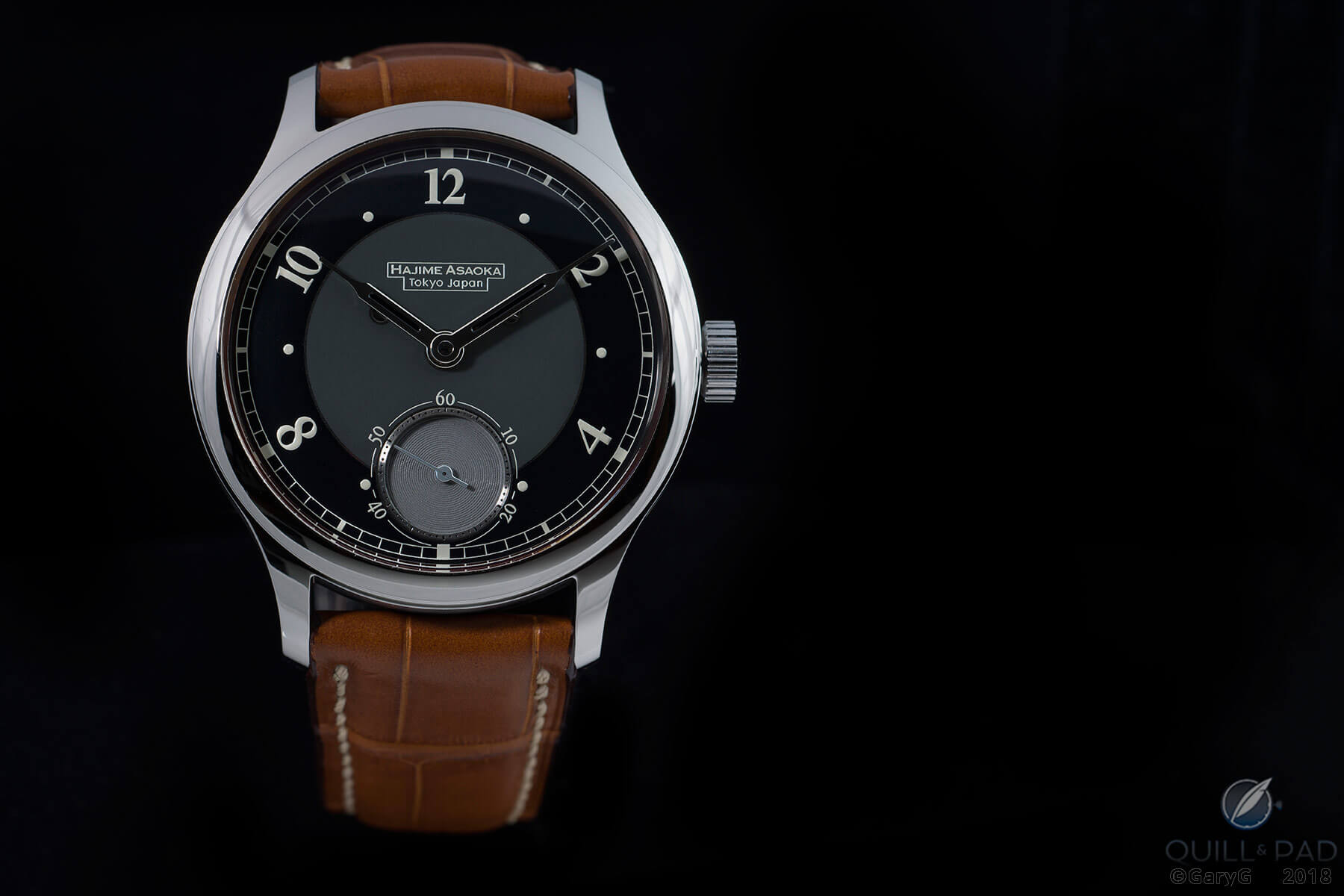
The author’s customized Tsunami by Hajime Asaoka
How the Hajime Asaoka Tsunami fits and why I bought it
In my pal Terry’s taxonomy of watch collecting, the Tsunami is pretty clearly a “patronage” watch: one that celebrates the ingenuity and hard work of a leading independent maker and supports his or her ongoing self-expression.
And this is a gorgeous piece! But there was something else that drew me to the Tsunami: its ability to serve as a versatile workhorse that could be worn for business and leisure and that would seem completely at home regardless of the occasion.
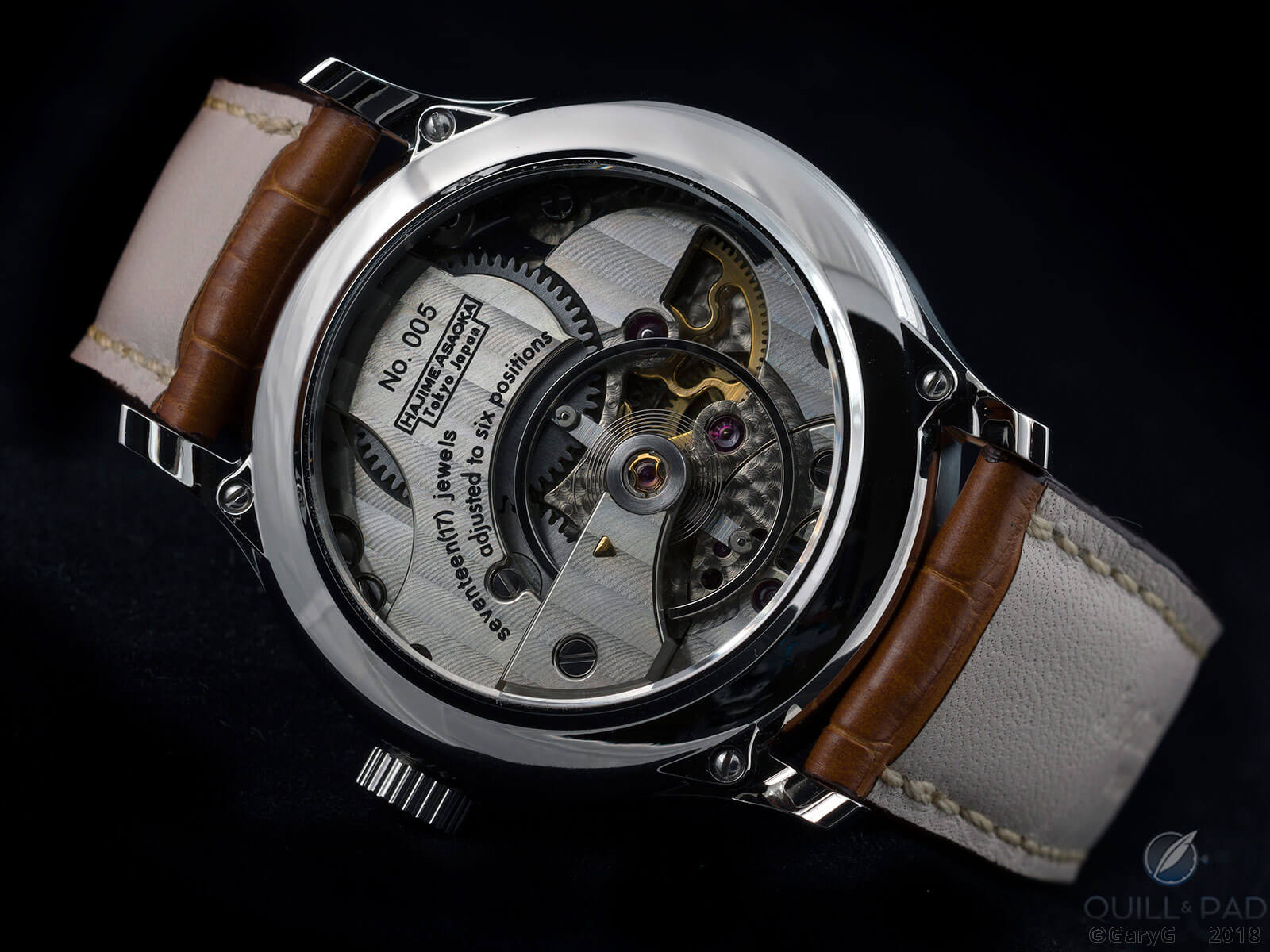
Straight to the back: movement view, Hajime Asaoka Tsunami
When it comes to defining what constitutes a great “daily-wear” watch, I’m sure that each of us has his or her own criteria and desires. For many, the need for robustness is at the top of the list, and so there are a lot of Casio G-Shocks and Rolex Submariners out there. For others, the desire for something dressier but still functional and somewhat subtle helps to account for the popularity of Jaeger-LeCoultre Reversos and simple Patek Philippe Calatravas.
Perhaps somewhere in between are pieces that span the gap between sporty and dressy, such as the Audemars Piguet Royal Oak.
When I first saw a photo of the Tsunami in 2012, it immediately occurred to me that this was a watch that I could imagine owning and wearing for a very long time with its handsome and rugged proportions, quite wearable at 37 mm in diameter, durable in steel, and with both striking looks and interesting technical features such as its 16 mm titanium balance.
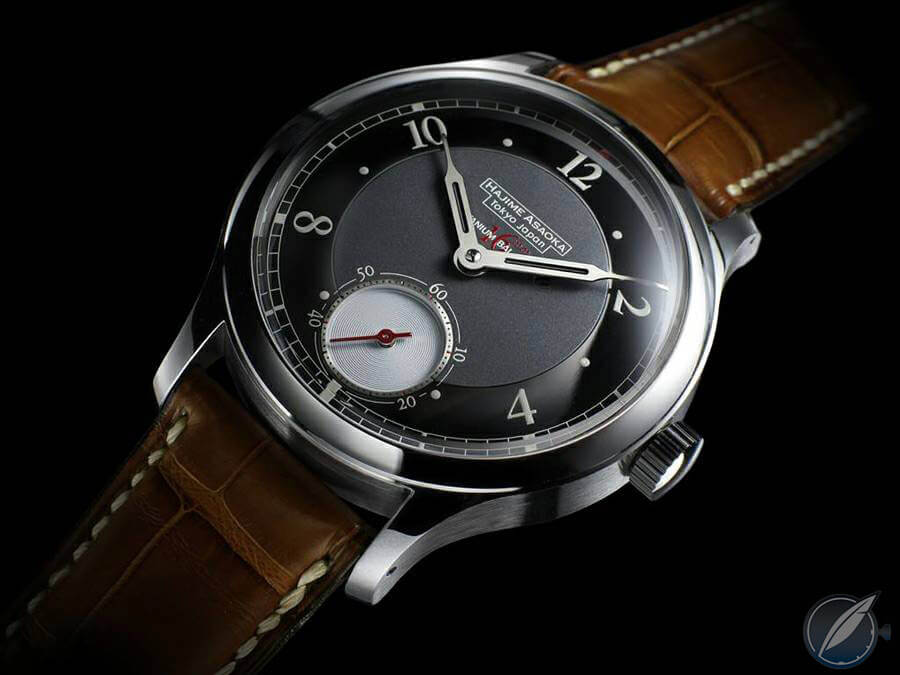
First of a line: Asaoka Tsunami No. 001 (photo courtesy Hajime Asaoka)
Buying the Hajime Asaoka Tsunami: the journey
And so, the quest began!
One of the great paradoxes of dealing with Asaoka-san has been that while he lives his life quite visibly through frequent and often quite detailed Facebook and Instagram posts (on both professional and personal matters), until his fairly recent relationship with business associate Noritake Sakurai he has been virtually impossible to contact, not just for me but for many frustrated would-be collectors around the world.
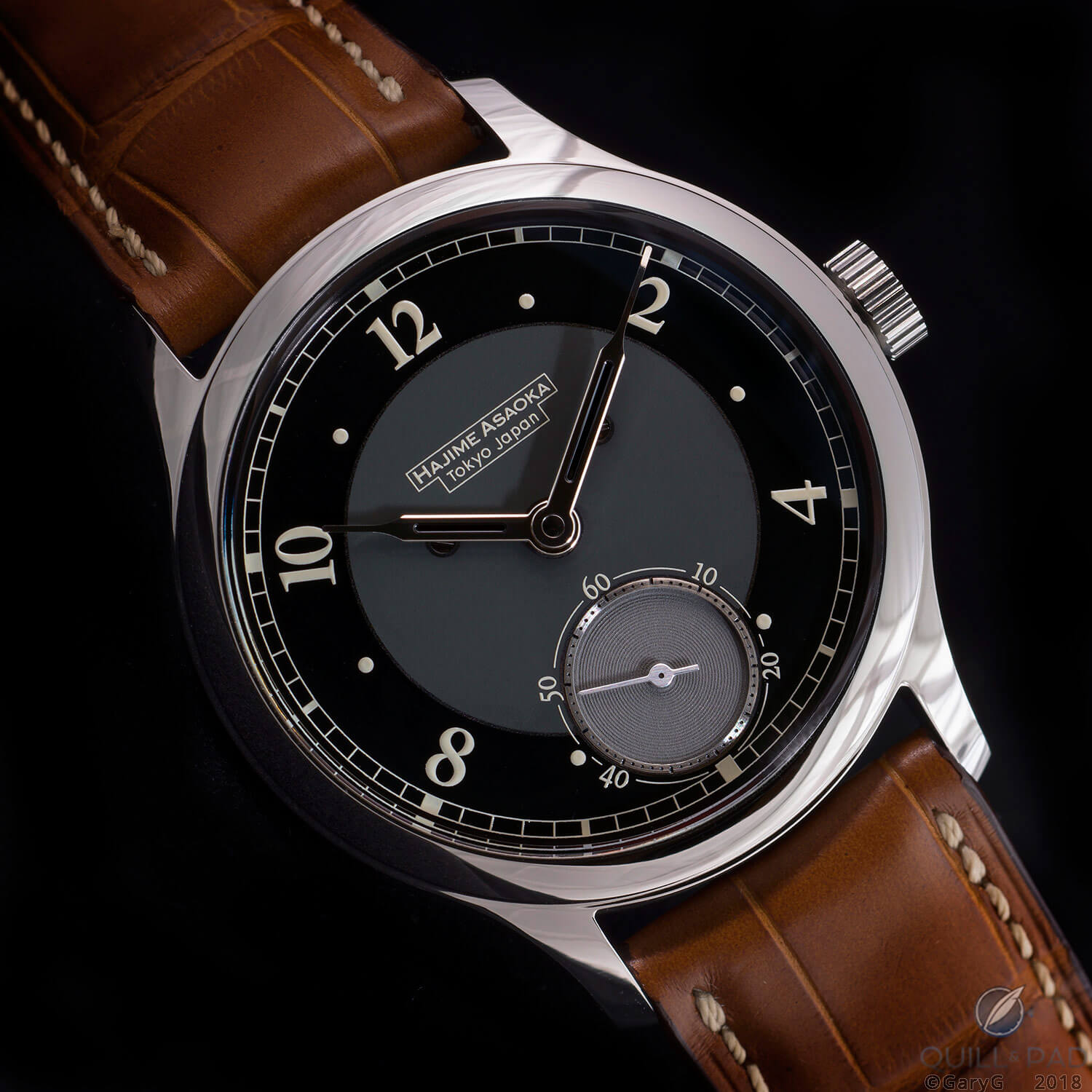
Elusive prey: Hajime Asaoka Tsunami
Message after message sailed off into the void over a period of almost three years until early 2015, when by a very fortuitous coincidence I sent a message to a Japanese collector friend who just happened to be sitting next to Asaoka in the AHCI booth at Baselworld!
My kind friend took on the role of intermediary, and through some fits and starts (including a failed attempt to order two identical Tsunamis as a pair of “buddy watches” with a good friend from Australia) I was finally able to lock in a subscription and place a deposit with delivery promised for 2016.
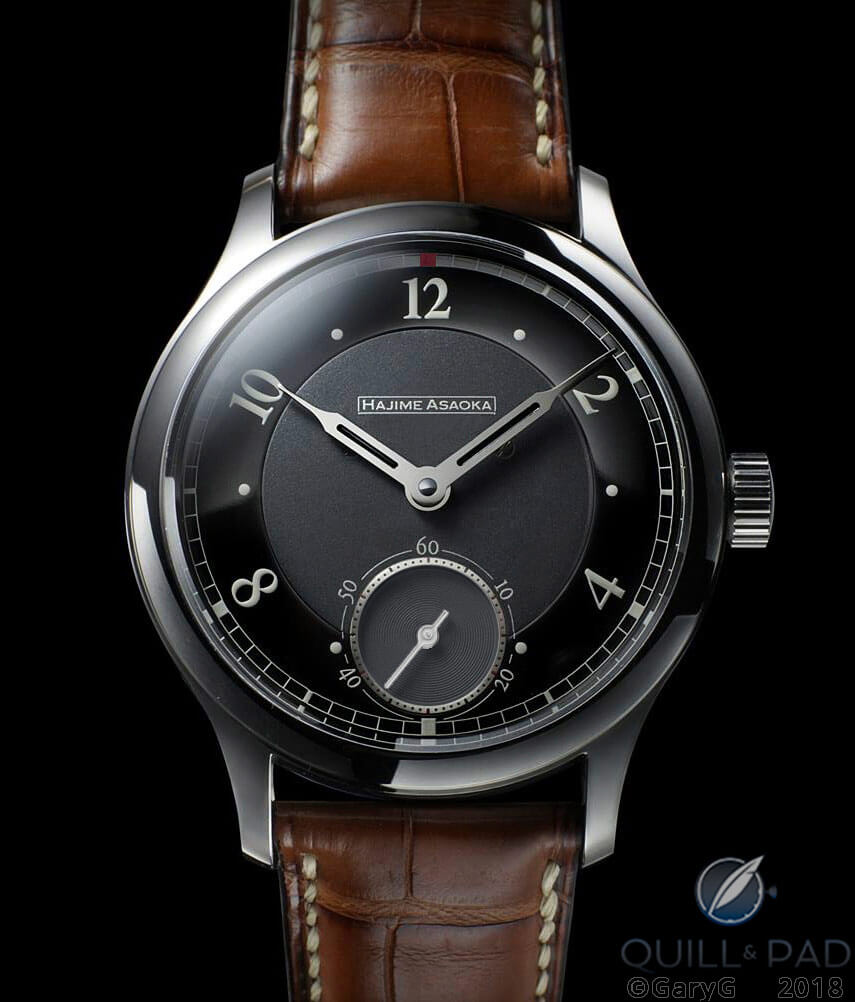
Early mockup by the author, with simplified logo and red index at 12 o’clock
As part of the specification process, we passed a number of potential options back and forth, including the one shown above for dial designs simpler than those on Tsunamis number 001 (pictured earlier in this article) and 002.
I was keen to have a very simple and sober dial-side appearance without the “16mm Titanium Balance” labeling of No. 001, and much simpler than the Deco-style appearance of No. 002 with its index at 12 o’clock reminiscent of an inverted NTT Docomo Tower.
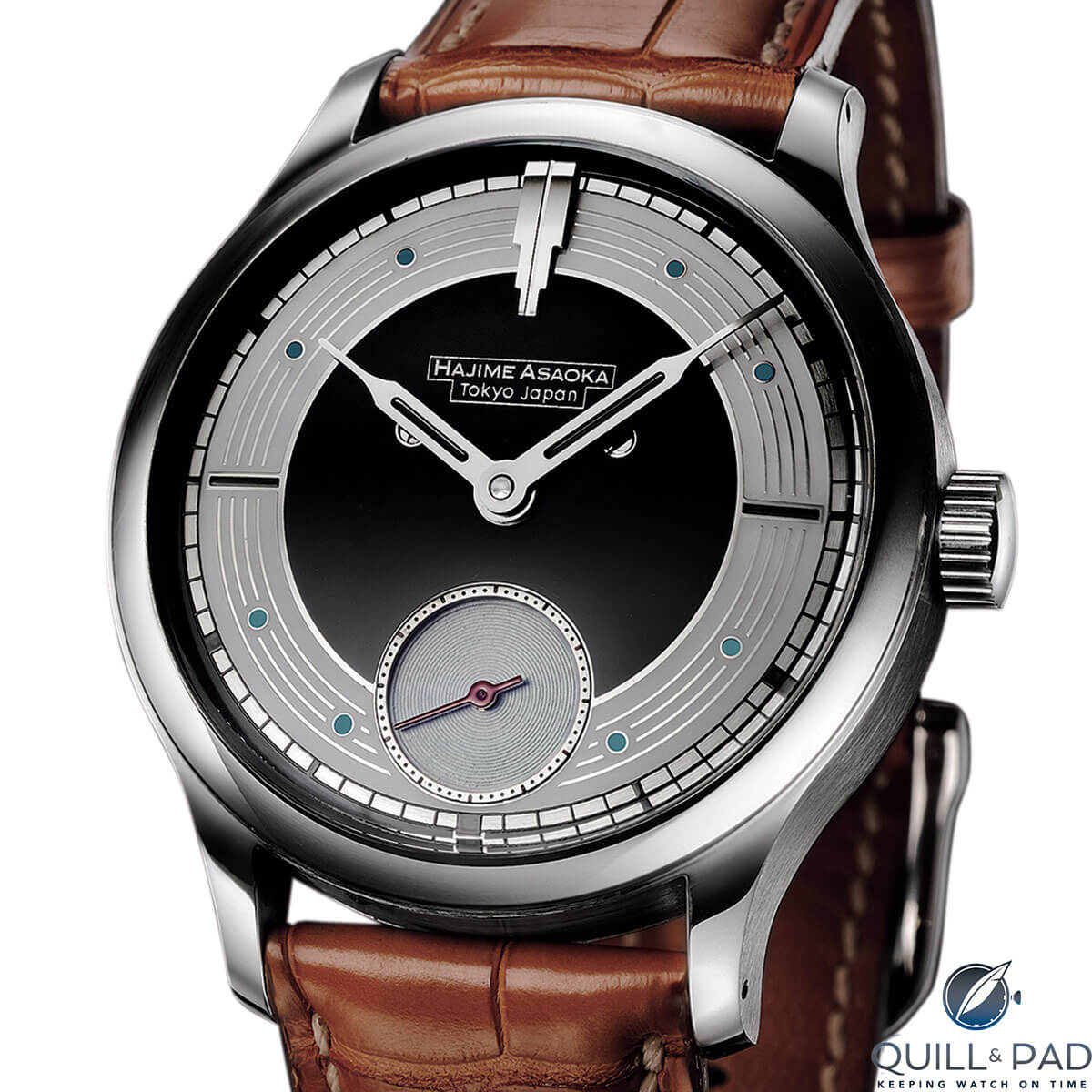
Striking, but not for me: dial of Asaoka Tsunami No. 002 (image courtesy tokeibegin.jp)
For better or worse, one of the big watch manufacturing groups solved the problem of the “titanium balance” labeling for me by asserting a patent on the use of that metal for watch balances; as Asaoka was in no position to afford a fight on the topic, some time was needed while he redesigned the movement to incorporate a 15 mm steel balance.
And then, more time passed. Quite a bit of it, in fact, including an entire year that Asaoka devoted to the design of his splendid chronograph but during which he did not make my watch – or as far as I can tell any other watch.
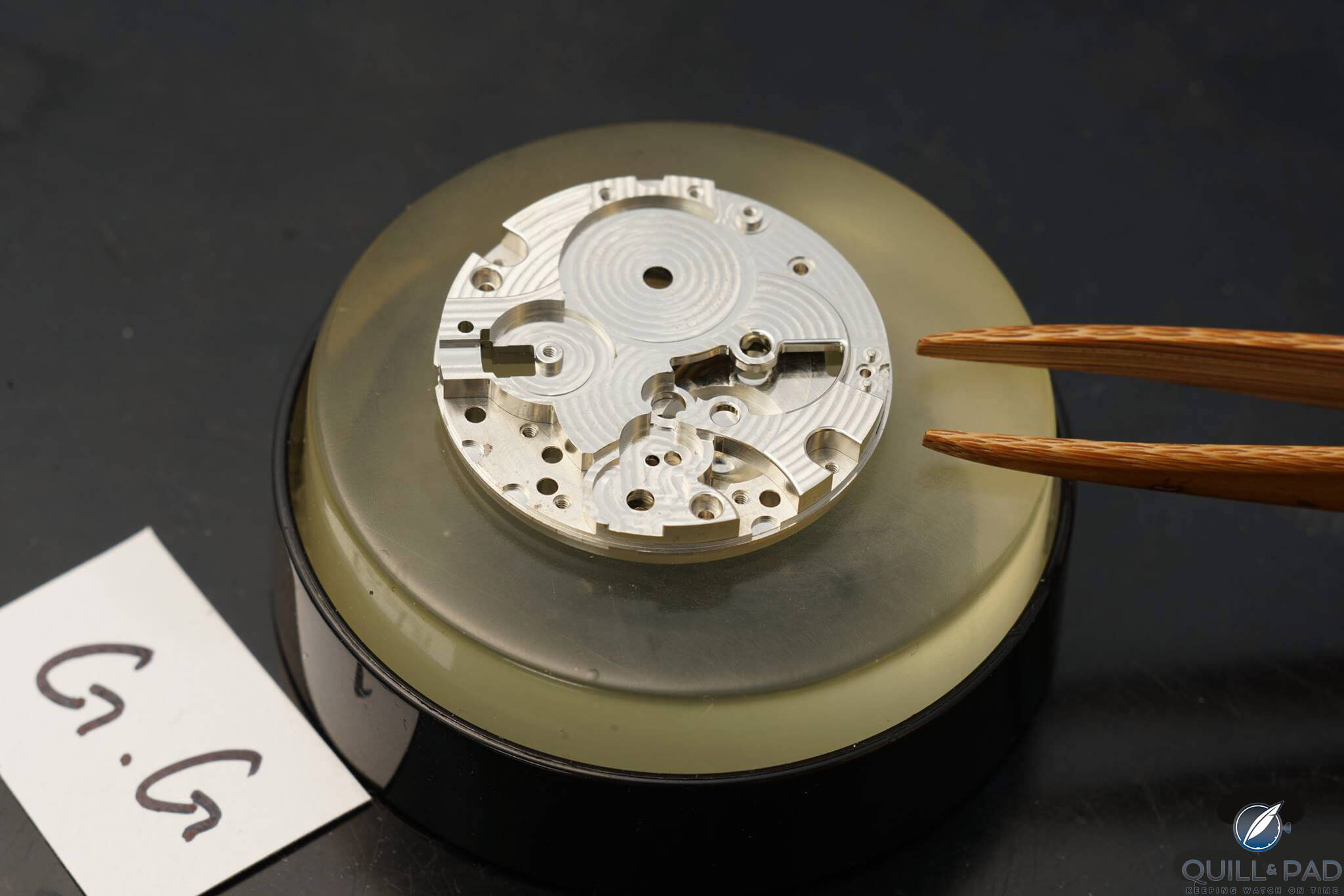
This one’s for you: plates and bridges of the author’s Tsunami shown in a Facebook post made by Hajime Asaoka
While I never had any worries at all that my piece might not be forthcoming, as you can imagine I was beginning to get a bit impatient when at last, slowly but surely, Facebook posts began to emerge showing the fabrication of my watch and describing the improvements relative to the first Tsunamis that Asaoka was making to my example, importantly including new approaches to dial making and printing of the indices.
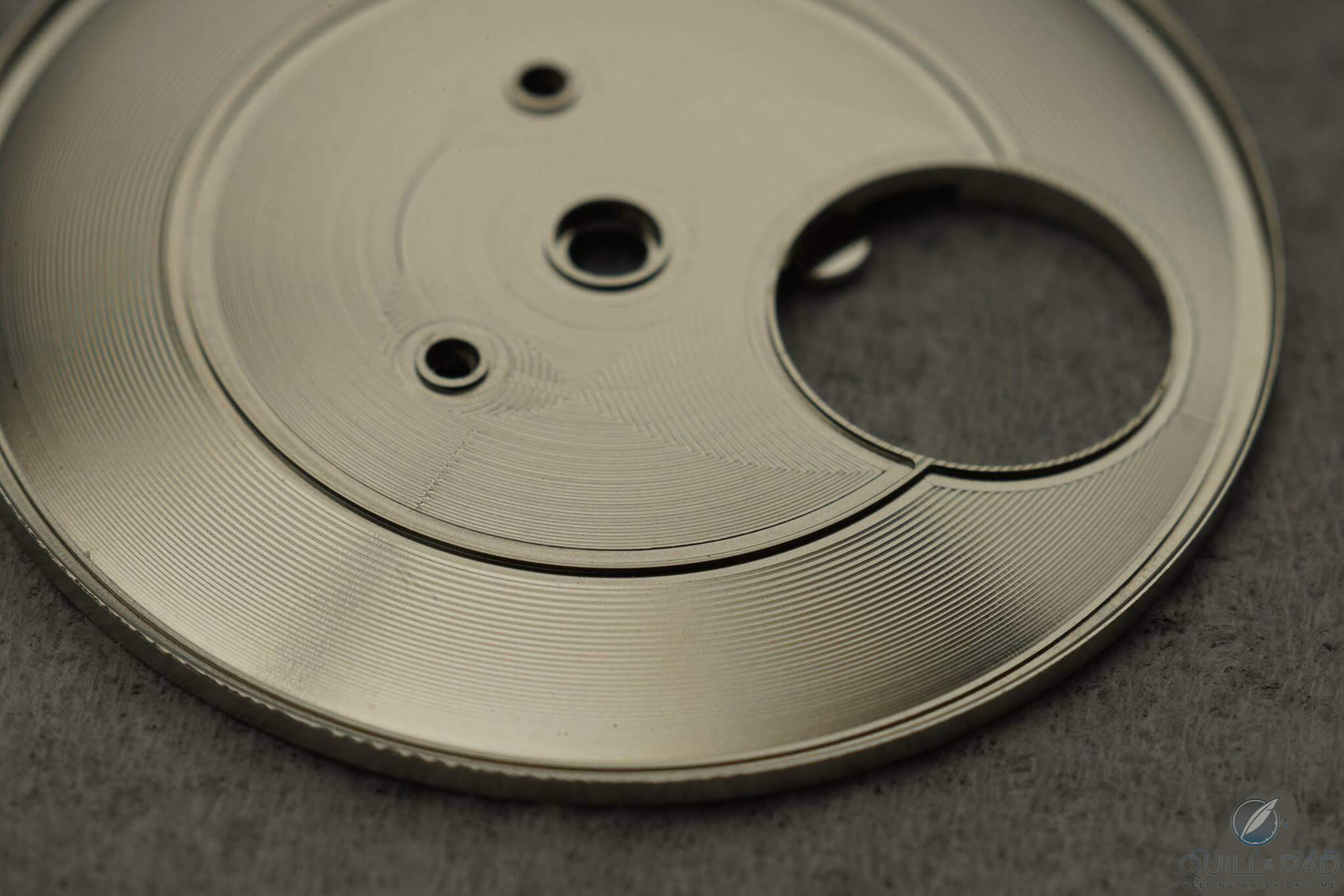
Dial blank of the author’s Hajime Asaoka Tsunami crafted from German silver (photo courtesy Hajime Asaoka)
Finally, at Baselworld 2018 the moment arrived: a delightful dinner with Asaoka, Sakurai, and longtime watch pal Michael at which I was presented at last with my Tsunami – and a request.
Asaoka was going to participate in the Watchmakers: The Masters Of Art Horology exhibitions of independent watchmaking in Rome, New York, Hong Kong, and London. Might I be willing to lend my watch for the tour?
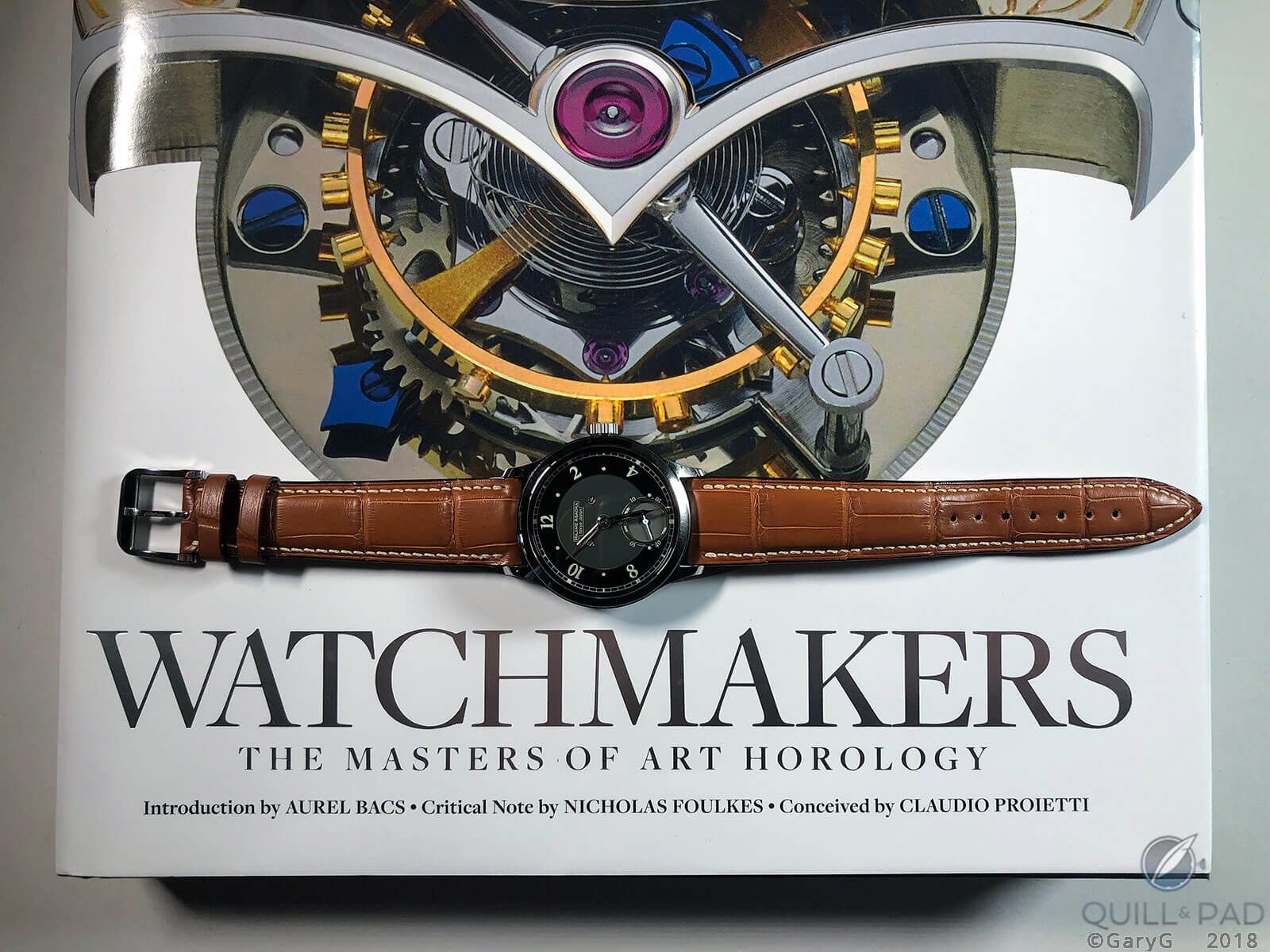
Easy come, easy go: world tour for the author’s Asaoka Tsunami (original book cover photo by Guy Lucas de Peslouan)
And just that quickly, “incoming” turned into “outgoing” until, six months later, Sakurai came to California with a fully refreshed version of my watch for a “re-delivery” lunch with some great friends.
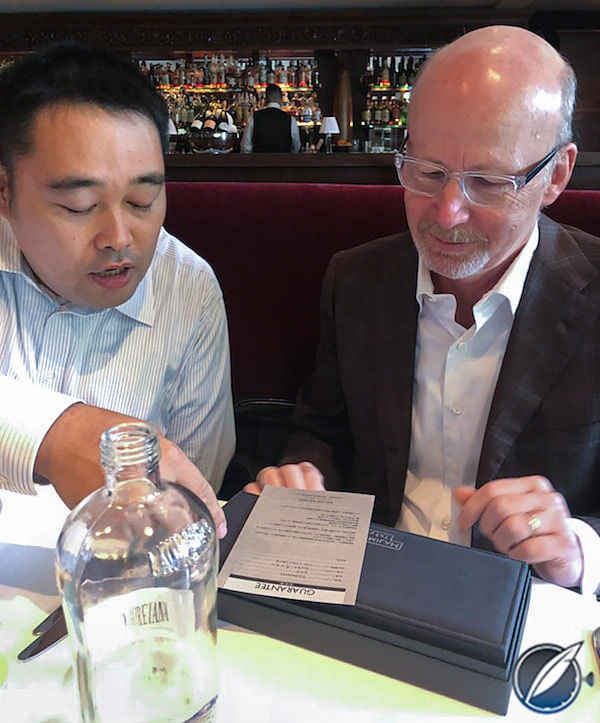
Noritake Sakurai reviews the Tsunami’s warranty with GaryG (photo courtesy AllenS)
Why I love the Hajime Asaoka Tsunami
I’d never even seen a Tsunami in person when I ordered mine, and after such a long wait the fear is always that reality won’t live up to one’s hopes. But what I love the most about my Tsunami is that it turned out to be better – cleaner, sharper, more solid – than I’d expected.
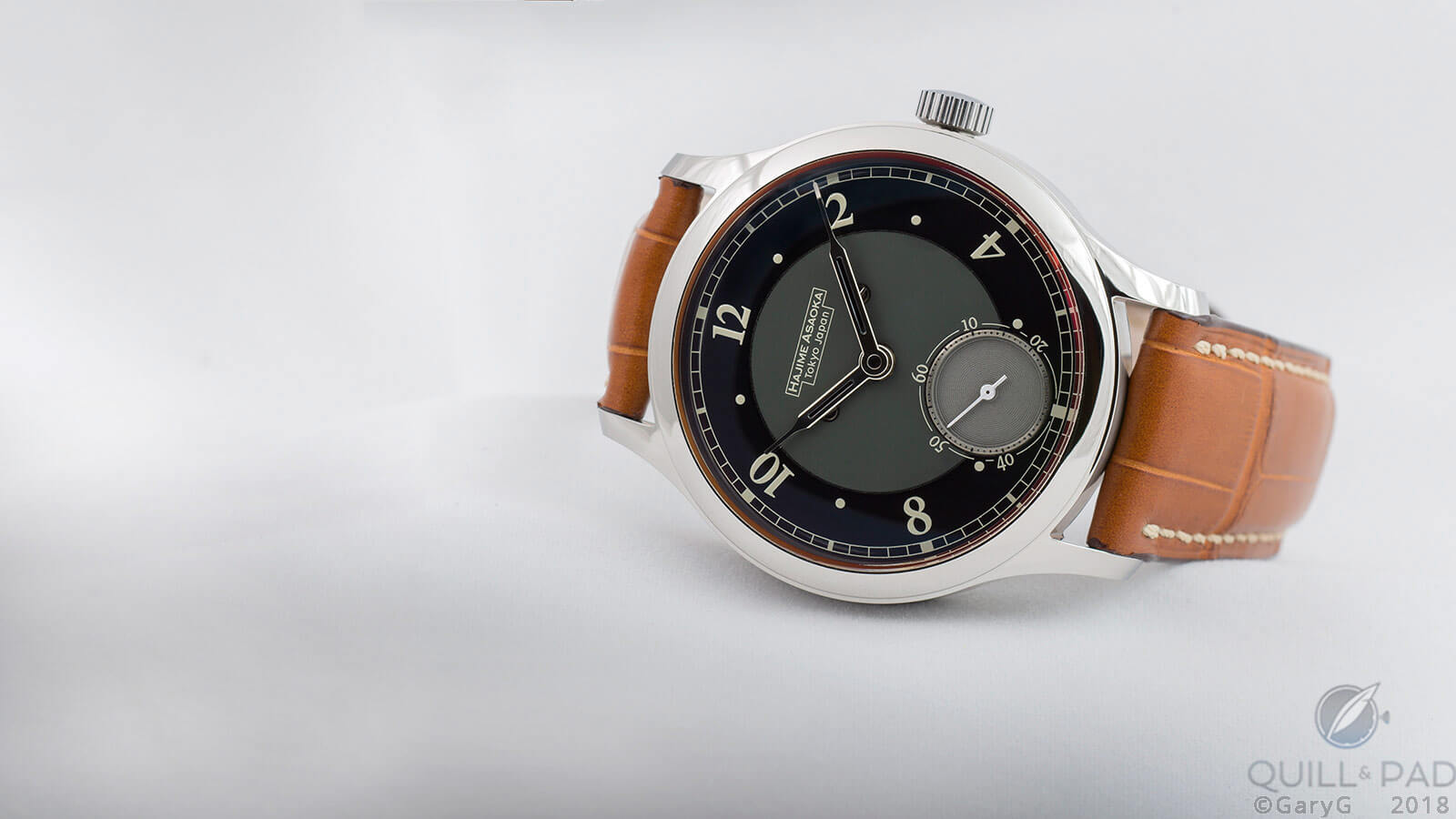
Lights, camera, action: Tsunami No. 005 by Hajime Asaoka
The case, made by Asaoka, has clear shapes and sharp edges, and the quality of both the polishing on the bright surfaces and brushing on the case band is superb.
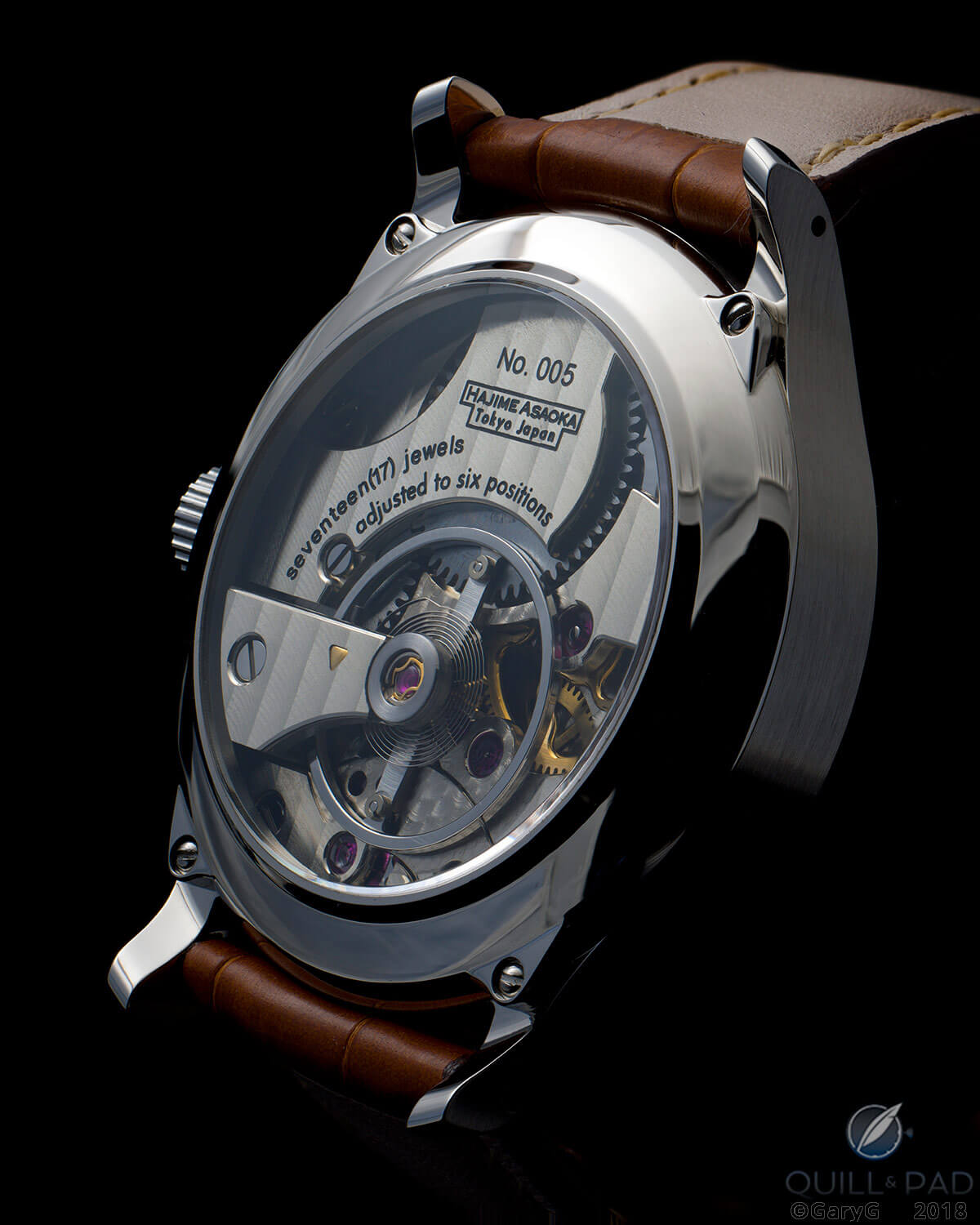
Rear profile view of the Asaoka Tsunami
The dial is massively improved from Asaoka-san’s first pieces; instead of being made up of a separate outer ring and a rough-surfaced matte central insert, the subtly domed one-piece German silver dial is now filled with multiple layers of enamel on the outer ring and features a glassy inner circle made from two blended colors of ceramic clay.
The “zen garden” surface of the seconds subdial is the visual icing on the cake of this small treasure under curved sapphire crystal.
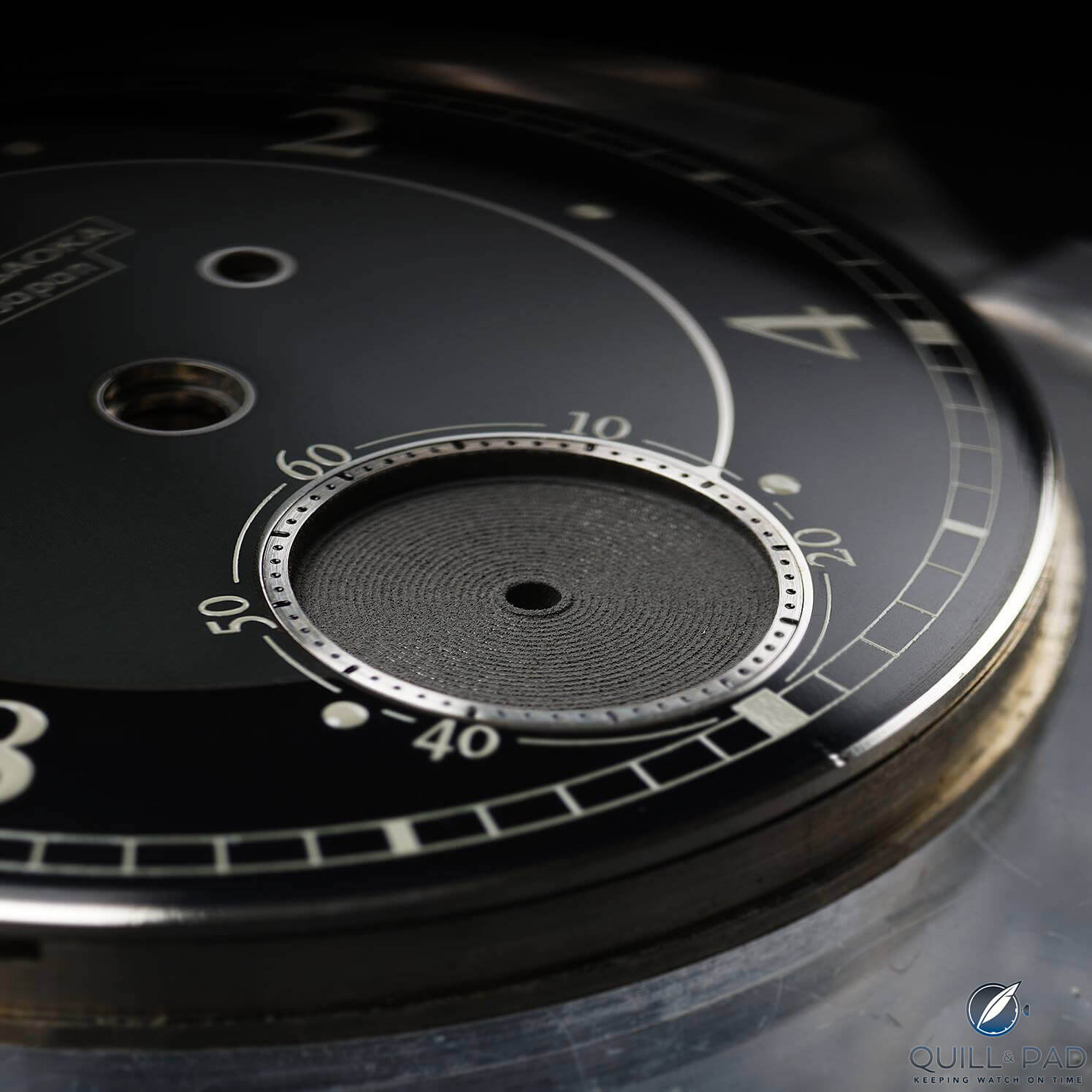
Dome-o arigato: domed surface of the Tsunami dial (photo courtesy Hajime Asaoka)
The printed indices are another great story, nicely raised through multiple applications of a mixture of inks developed by Asaoka and applied with a gelatin tampon he makes himself using a shot glass as a mold!
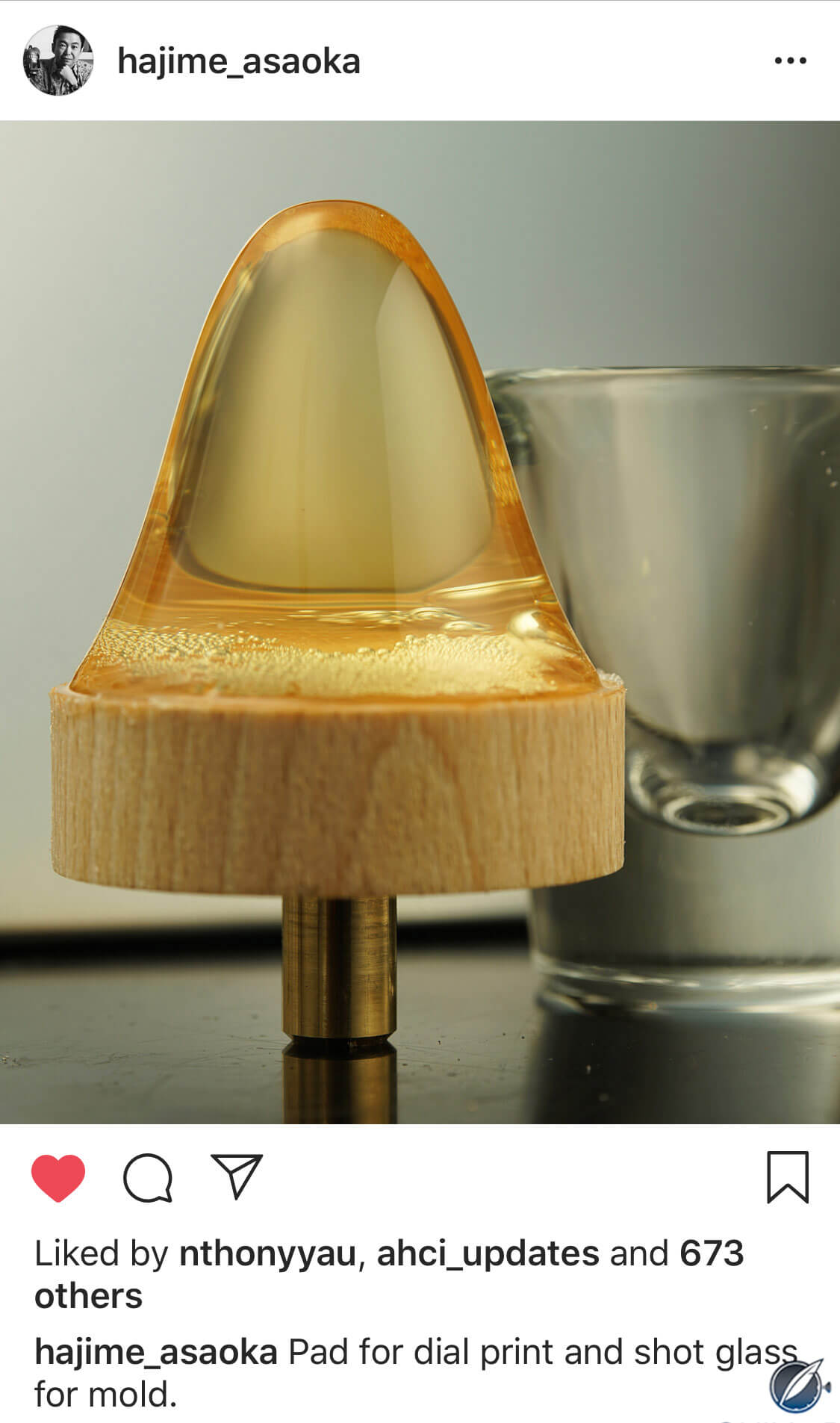
Printing tampon and mold from an Instagram post by Hajime Asaoka
On the back side, the movement has the type of visual and structural depth that I like, and that still-substantial 15 mm balance wheel draws the eye. The balance itself hides a “secret” poising method that allows it to swing symmetrically without the use of peripheral weights.
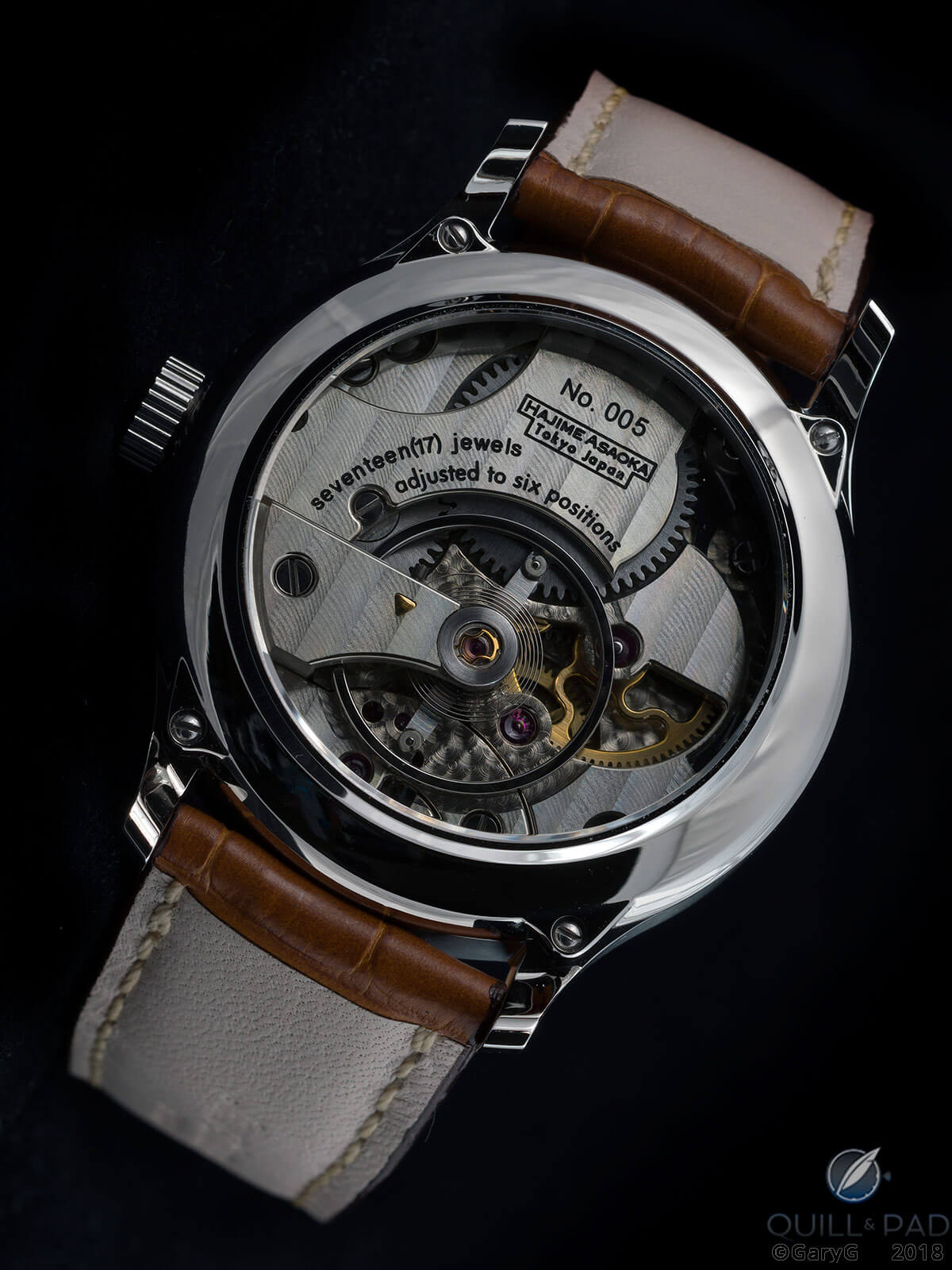
Into the depths: movement view, Asaoka Tsunami
If you’ve been studying the movement photos at all, you’ve no doubt noticed what a friend of mine has dubbed “the Tako Wheel”: that octopus-shaped wheel beneath the balance. If you have a half million bucks or so, you can get the same kind of wheel on a Patek Philippe Reference 5016, with admittedly somewhat better finishing and as part of a minute repeating tourbillon perpetual calendar.
But let’s not split hairs here, shall we?
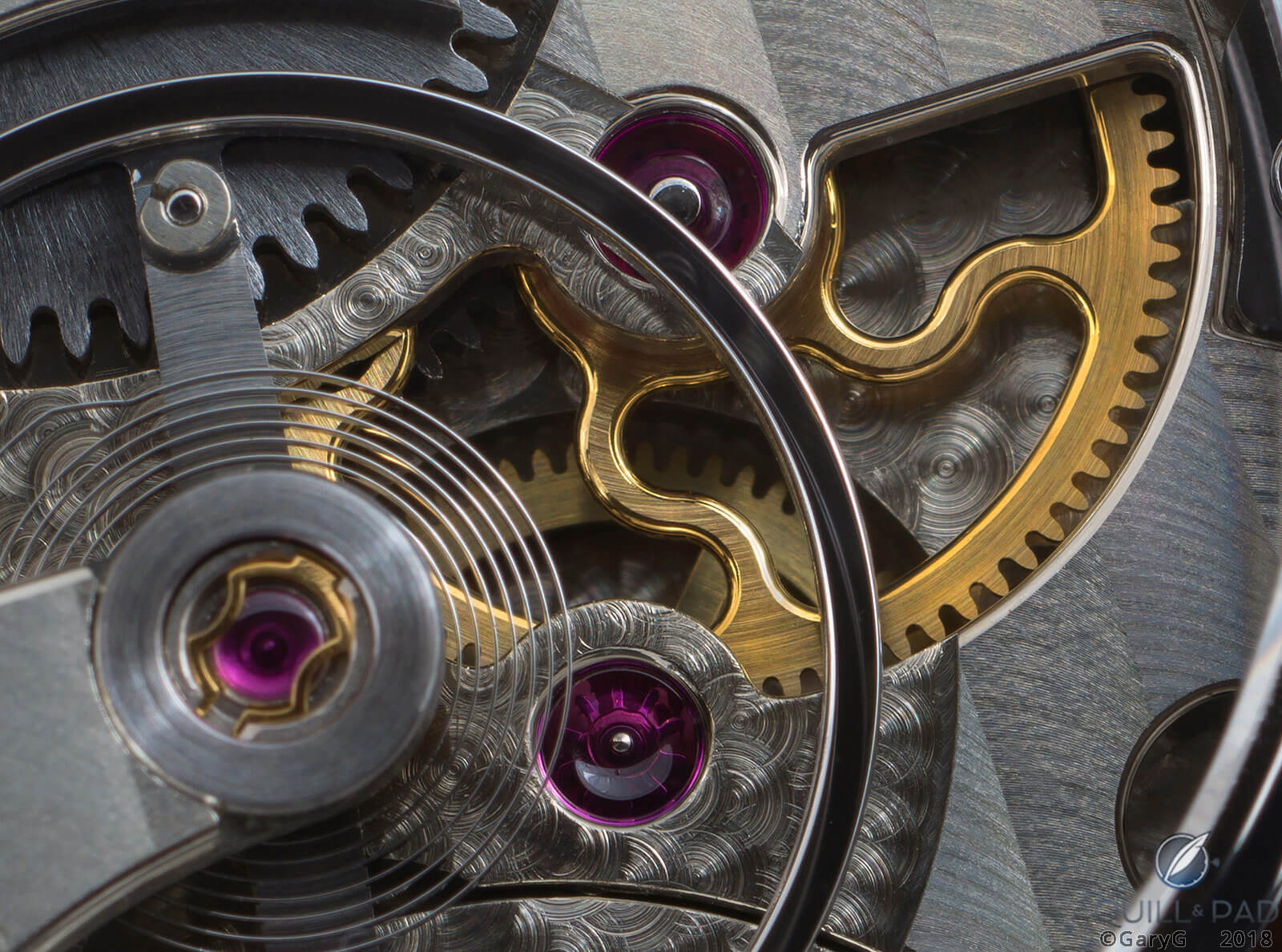
Movement detail, Asaoka Tsunami with octopus wheel
Speaking of finishing, the overall movement finishing is of a very solid quality in my view; in macro views we don’t see the buttercream-smooth striping or polished tooth profiles of a Philippe Dufour Simplicity. But the movement pops very nicely indeed as seen with the naked eye.
The Tsunami winds with a satisfying, firm click that is a bit chunkier than that of, say, an A. Lange & Söhne Datograph, but considerably kinder to the fingers than the super-stiff action of a Peseux 260.
And to return to the external elements of the watch, the handmade buckle with its subtle curves is a treat to peek at from time to time and easy to use.
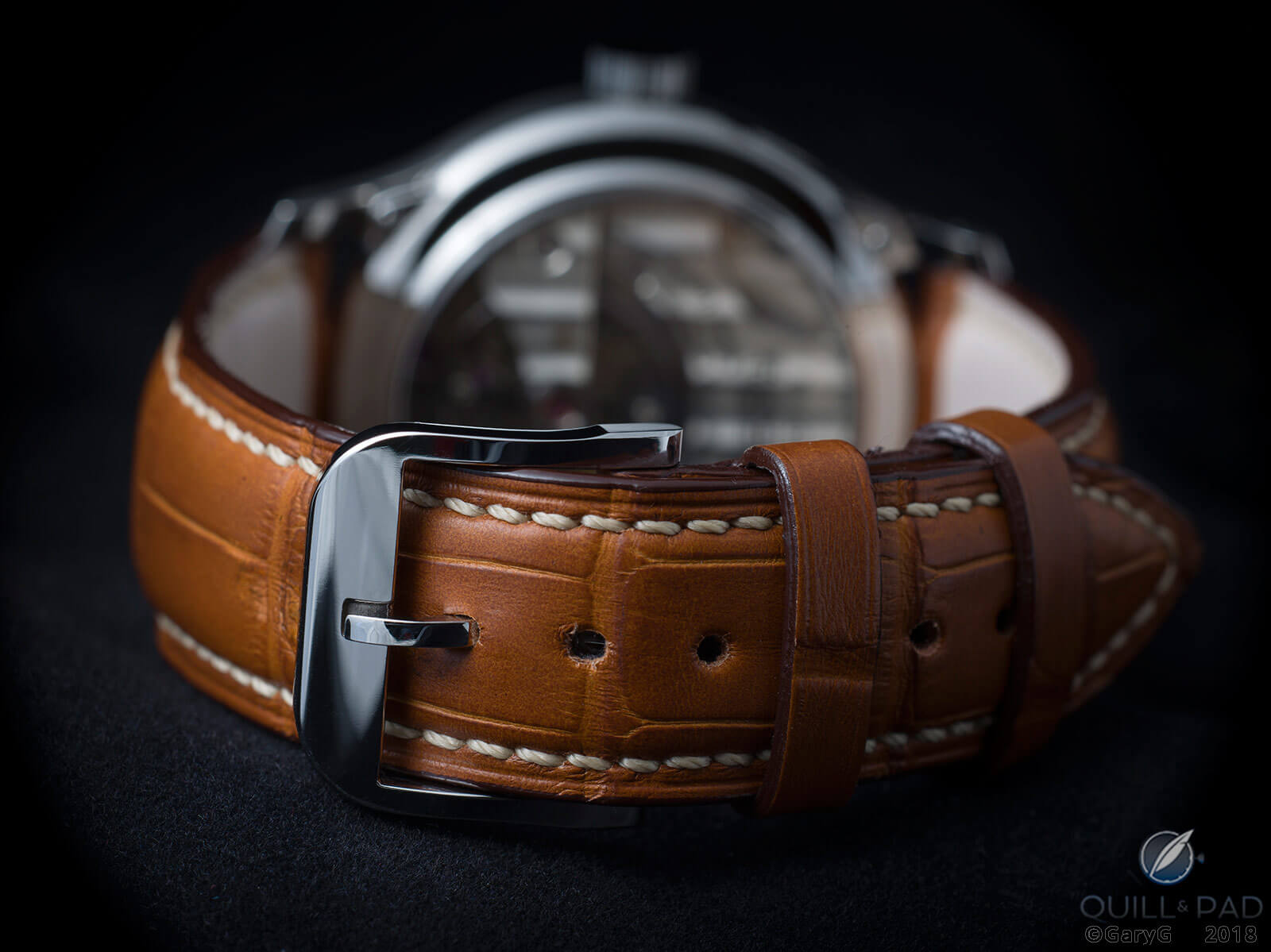
Handmade buckle, Tsunami by Hajime Asaoka
Finally, it’s all about the people! Getting to know Messrs. Asaoka and Sakurai and sharing not one, but two delivery celebrations with groups of watch buddies have already added a great deal to how special this piece is to me.
And knowing that enthusiasts around the world will have had the opportunity to see my watch as part of the “Watchmakers” exhibition and its related book makes the entire experience of owning Tsunami No. 005 even more fun.
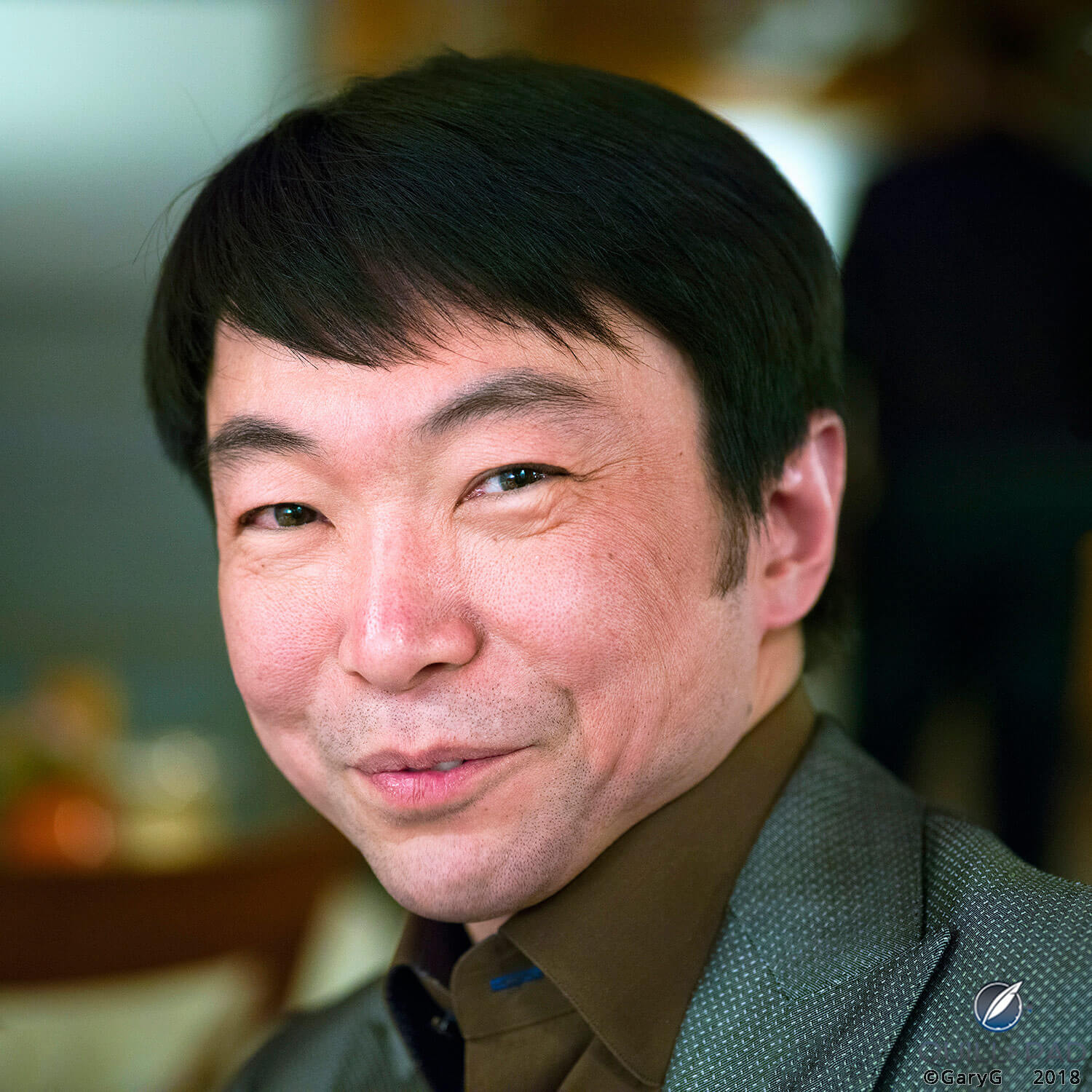
Meet the maker, want the watch: Hajime Asaoka at Baselworld 2018
Hajime Asaoka Tsunami on the wrist
I’ve now worn the Tsunami for a couple of weeks with dress shirts, golf shirts, and even tee shirts, and it does not disappoint.
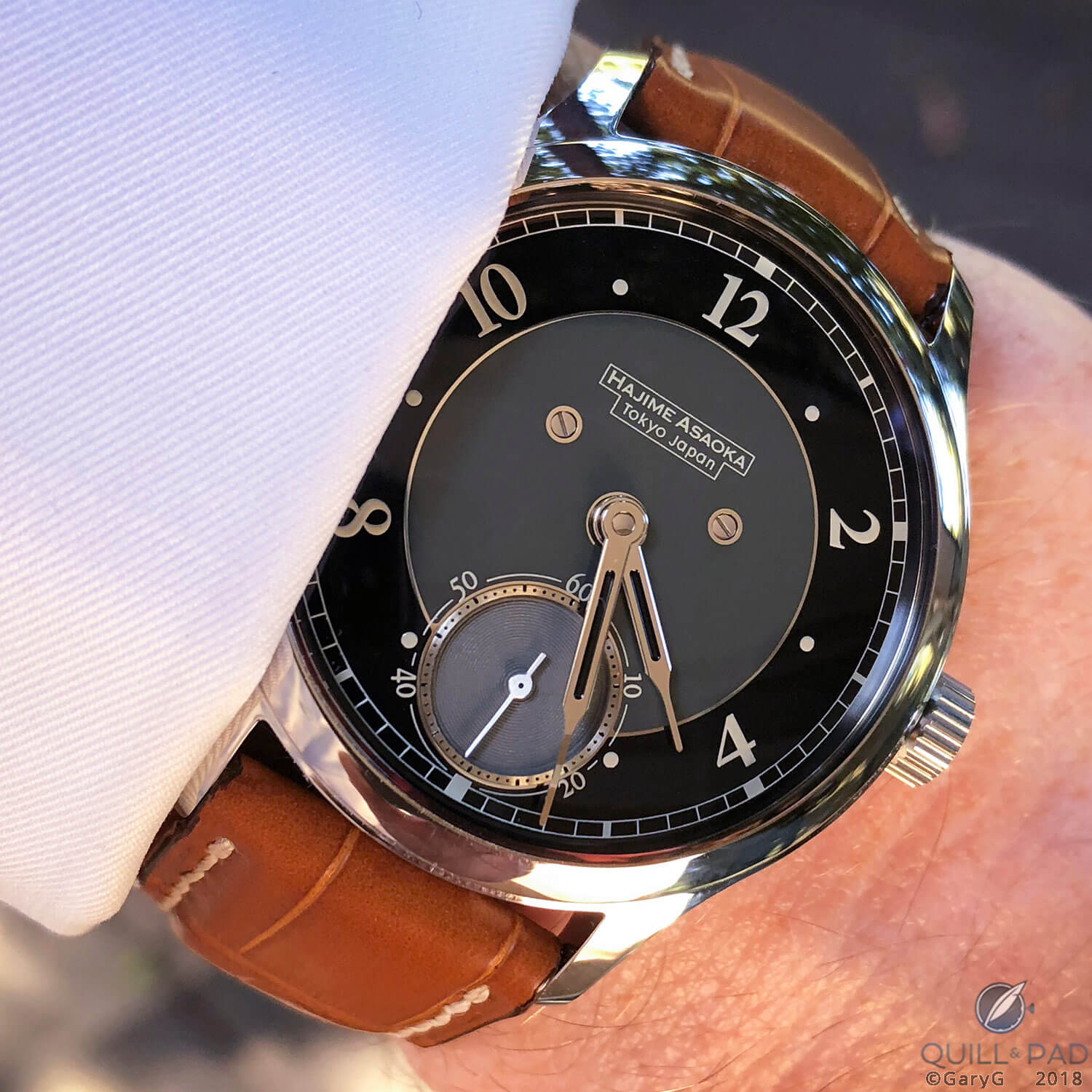
On the wrist: Hajime Asaoka Tsunami
At 37 mm in diameter and with a moderately wide bezel and black and grey dial, it can seem a bit small when strapped on immediately after wearing a considerably larger piece, but that sensation quickly passes.
For comparison purposes, take a look at the Tsunami in the photo below next to the 37 mm Jaeger-LeCoultre Futurematic Jumbo and Philippe Dufour Simplicity. In my view, the Tsunami gives up nothing in terms of wrist presence to either of these two favorites of mine.
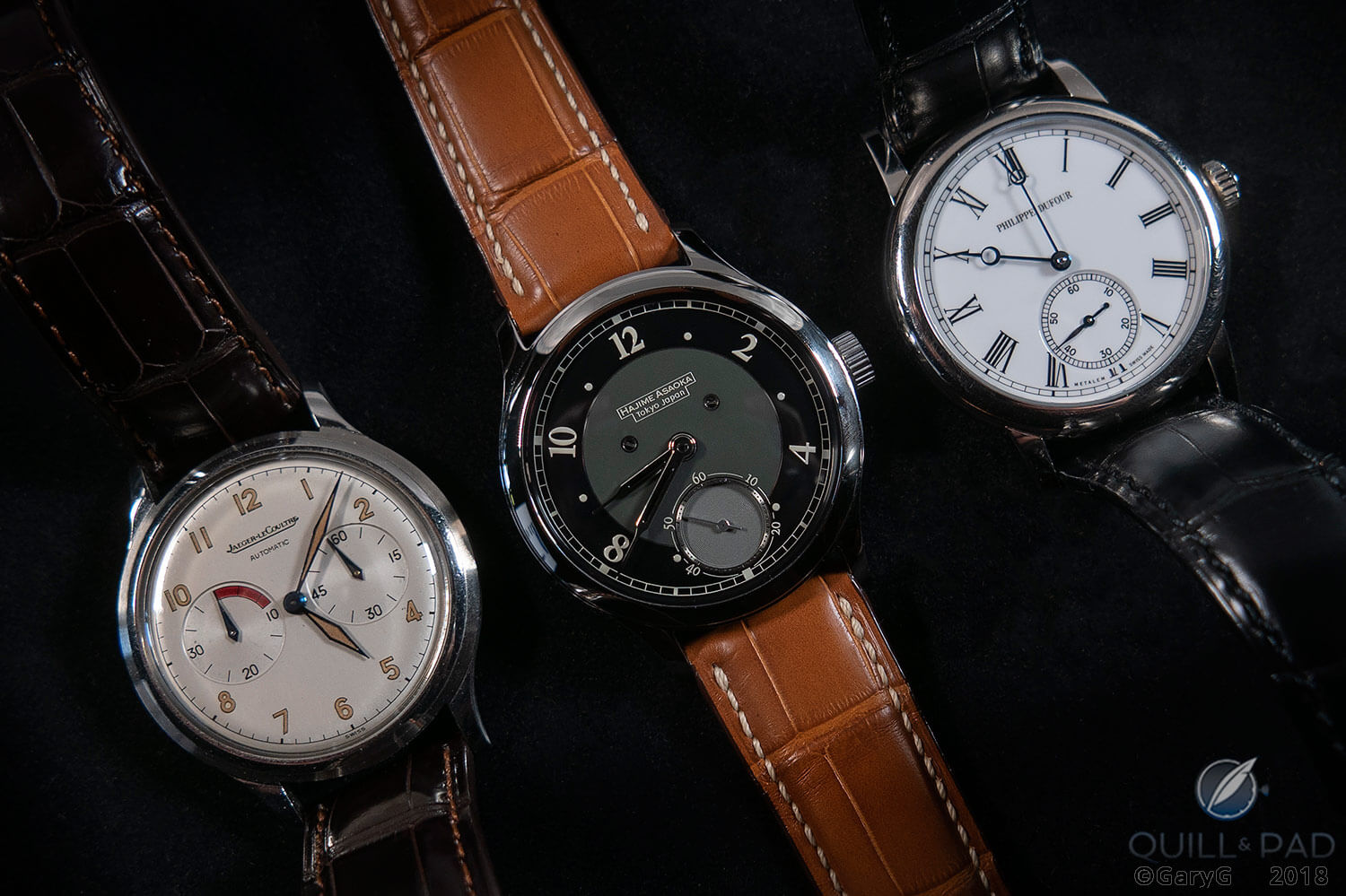
Size comparison: Jaeger-LeCoultre Futurematic, Asaoka Tsunami, Philippe Dufour Simplicity
Any quibbles?
I’m still very much in the honeymoon period with this watch so if there’s anything that bothers me too significantly about it I haven’t discovered it yet!
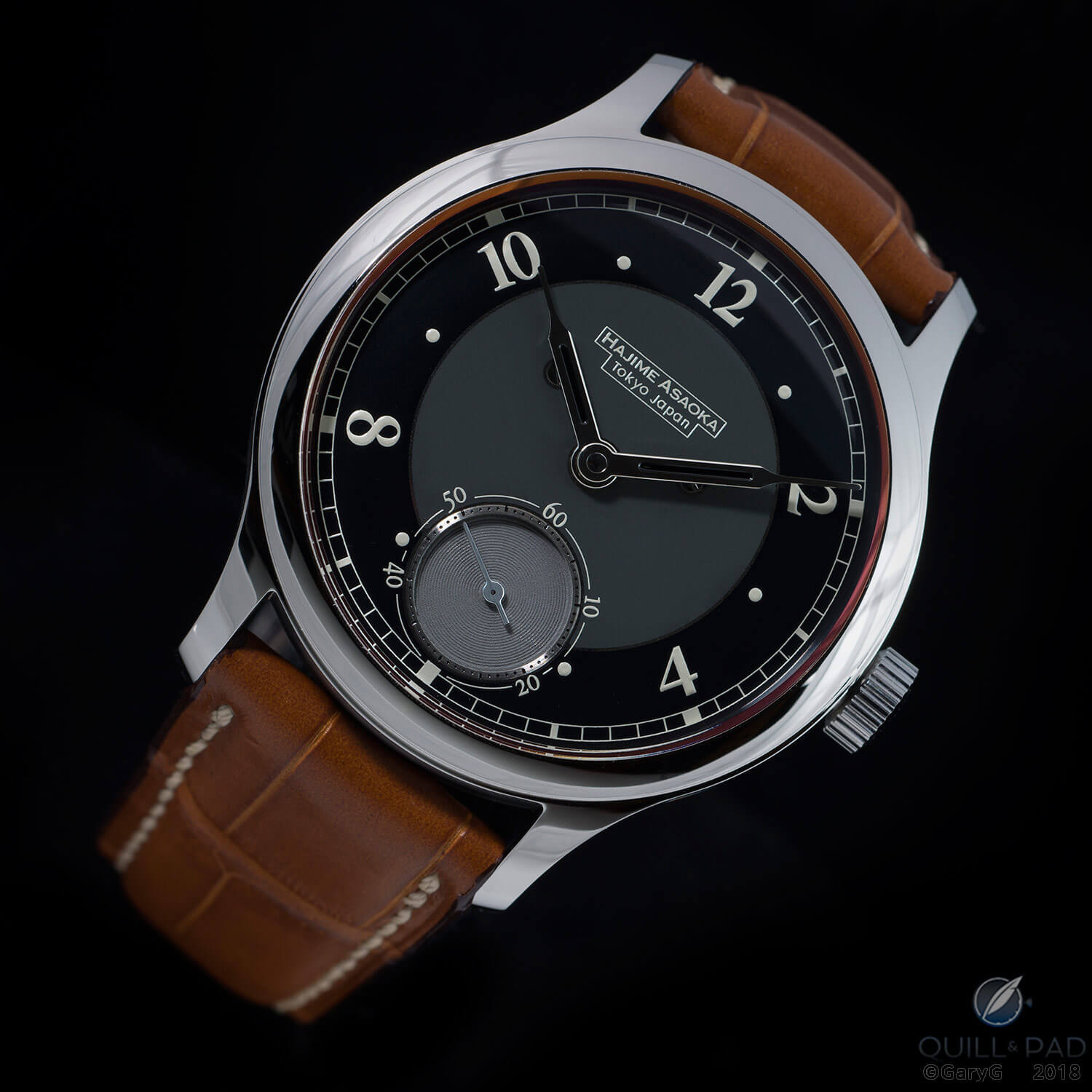
Big appeal, small package: the Tsunami from Hajime Asaoka
Of course, I wish that the piece had been delivered on its original schedule, but in the interim period Asaoka seems to have raised his game substantially in areas such as dial making so I can’t be too unhappy about it.
In terms of the watch itself, I would have preferred solid external surfaces on the lugs to the pierced lugs that it actually has; this is one consequence of Asaoka making his own cases, but I might humbly suggest that going forward he consider developing the capability for internal drilling of the spring bar holes.
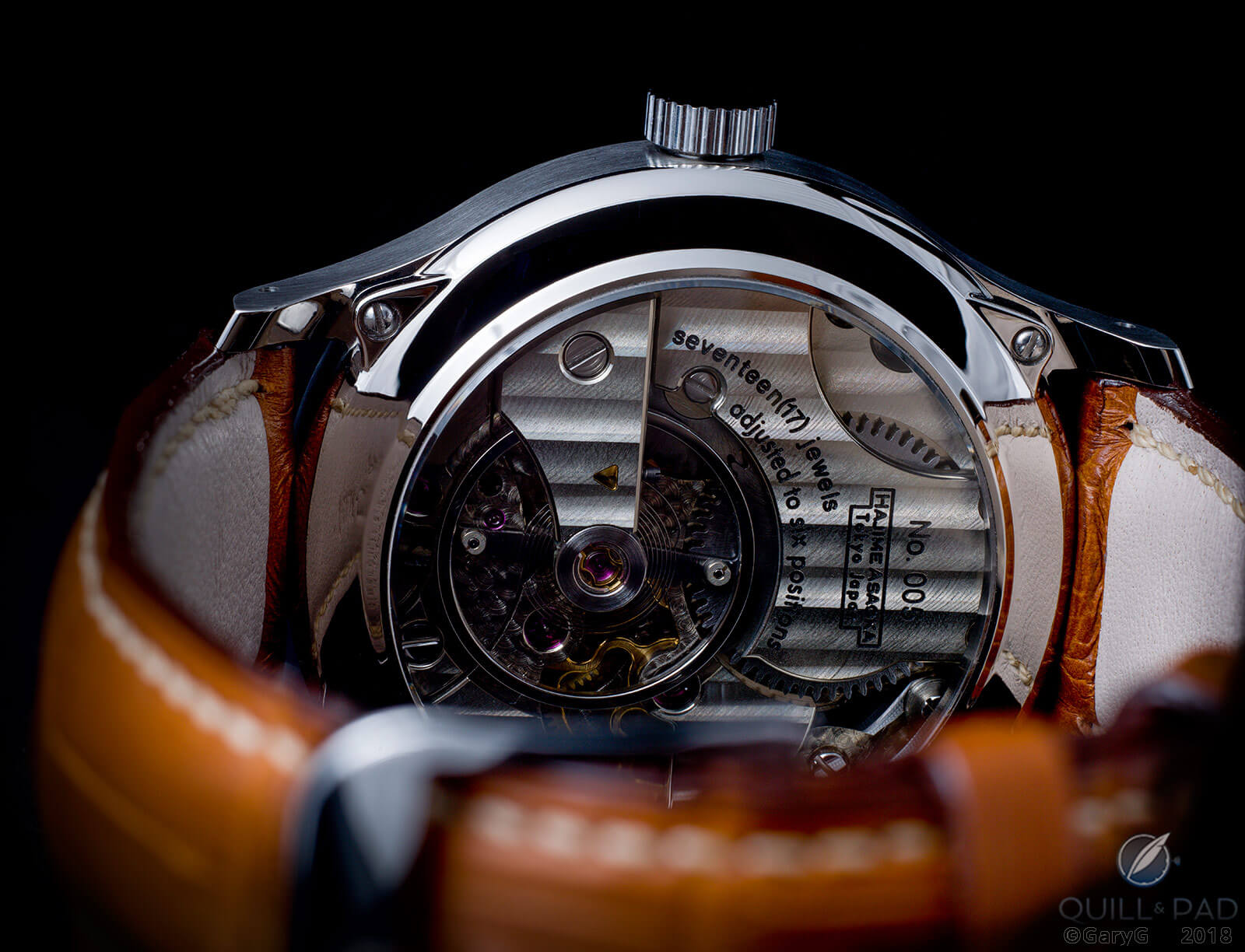
Consistent time: movement view, Hajime Asaoka Tsunami
Finally, while the good news is that my Tsunami keeps quite consistent time so far in real-world conditions, the bad news is that so far the consistent time seems to be about 9 seconds per day fast.
I’m hopeful that a relatively simple adjustment will be possible at some point to bring the deviation closer to zero. Happily, the current performance of the watch is still within my benchmark range of being able to set a watch precisely on Monday morning and having it indicate within one minute of the correct time when I take it off on Friday evening.
Closing thoughts
It’s a privilege for me to own any watch from one of today’s leading independent watchmakers, and even more so such a rare example from a watchmaker who is so single-mindedly devoted to his art.
I’m also very happy to have a watch like this one in my collection that can serve as a daily wearer but isn’t a piece that I’m going to see on other people’s wrists; the ability to follow my own instincts and collect somewhat off the beaten path is something I very much enjoy.
If anything, my concern is that the Tsunami is just too nicely made to become a true daily-wear piece for me; but I’m more than willing for now to keep wearing it to see how that works out!

Parting shot: taking final delivery of the Tsunami from Hajime Asaoka (photo courtesy AllenS)
For more information, please visit www.hajimeasaoka.com.
Quick Facts Hajime Asaoka Tsunami
Case: 37 mm, stainless steel case with polished bezels and brushed case band; domed front saphhire crystal and exhibition back with sapphire crystal
Dial: German silver base milled in cloisonné style with lacquer and clay surfaces; grooved seconds subdial; printed numerals, logo, and indices
Movement: manually wound, 40-hour power reserve; 18,000 vph/2.5 Hz frequency
Functions: hours, minutes, subsidiary seconds
Price: JPY 3 million (approx. $26,700)
Production years: 2012 onward; fewer than 10 examples made as of late 2018
* This article was first published on October 29, 2018 at Why I Bought It: Hajime Asaoka Tsunami.
You may also enjoy:
A Superlative Self-Made Chronograph From Self-Taught Independent Watchmaker Hajime Asaoka
You Are There: ‘Watchmakers: The Masters Of Art Horology’ At The Maxxi Gallery, Rome
Behind The Lens: Beat Haldimann’s H1 Flying Central Tourbillon
Leave a Reply
Want to join the discussion?Feel free to contribute!





















































Look at the size of that balance wheel! Glorious, and gives Voutilainen a run for his money. Did you get it regulated, Gary?
I’ll have to hook it up to my timing app, but it seems to keep splendid time!
You sold it didn’t you. Lol
I guess he doesn’t. My friend is still waiting for his Tsunami, already more than 1.5 years after placing an order.
Hey Chia-Ming. It looks like we’ll just have to guess.
Did I sell mine? Definitely not! Have it, wear it, love it — on my IG feed you can see a recent wrist shot from our vacation in Santa Fe…
Best, Gary
Cool, thanks Gary. Just checked your IG and did a big contented sigh. It looks amazing in that shot, the different tones explode in that light.
I hope GS are watching.